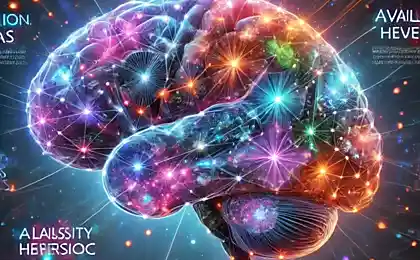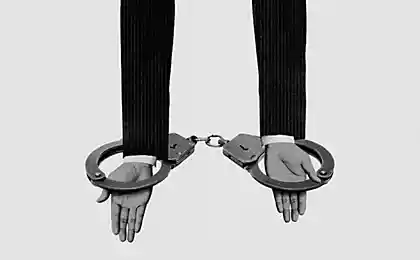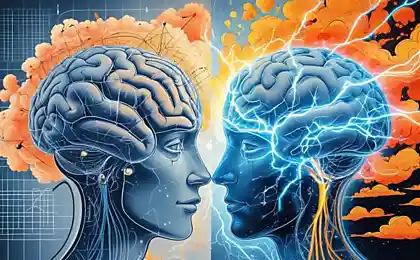193
6 Types of Denial You Use If You Don't Like Your Life

We all want to be happy and live a full life. But sometimes, instead of acknowledging problems and working to solve them, we resort to various forms of denial. This psychological defense mechanism helps reduce anxiety in the short term, but in the long run it only exacerbates our problems and hinders personal growth.
Understanding the different types of denial is the first step in overcoming this destructive defense mechanism. By learning what kinds of denials you are prone to, you can develop strategies to overcome them and start living more conscious, authentic, and happy lives.
According to research conducted at Stanford University, more than 70% of people regularly use some type of denial in their daily lives, often without even realizing it. People who were able to recognize and overcome their denial mechanisms reported significant improvements in psychological well-being.
1. Denial of reality
The most basic and common type of denial is the simple denial of facts. "I don't have a drinking problem," "My marriage is fine," "My job doesn't negatively affect my health" are all examples of outright denial of reality.
Denying reality is dangerous because it prevents us from starting to solve the problem. We cannot correct what we do not recognize. It's like ignoring a leaky roof -- it won't stop leaking just because we pretend everything's okay.
Signs of denial of reality:
- Ignoring the negative consequences of your actions
- Refusing to listen to the concerns of loved ones
- Avoiding talking about certain topics
- Explanation of obvious problems by external circumstances

2. Minimizing problems
When minimized, a person acknowledges the existence of a problem but downplays its significance or potential consequences. “Yes, I sometimes spend too much, but it’s not that scary,” “I know I put off important things, but everyone does,” are typical statements reflecting this type of denial.
Minimization is especially insidious in that it creates the illusion of awareness. We think that once we have recognized the problem, we have already taken a step towards solving it. In fact, while underestimating the gravity of the situation, we continue to delay necessary action.
Research by psychologists shows that people who tend to minimize problems are more likely to face a “accumulation crisis” – a situation where neglected small problems suddenly combine into one large-scale catastrophe.
How is minimization manifested:
- Comparing your problems to those that are more serious (“Others are worse”)
- Jokes about serious problems as a way to ignore them
- Focusing on the short-term, ignoring the long-term consequences
- Rationalizing problem behaviors ("This is normal in our culture/age/profession")
In this type of denial, a person recognizes the problem, but shifts responsibility for it to others. “I wouldn’t be angry if you weren’t provoking me,” “I would have succeeded by now if it weren’t for society/system/government,” such statements point to projection.
Projection allows us to maintain a positive image of ourselves while freeing us from the need to change. In the end, it deprives us of power and control over our own lives, because the source of problems is always somewhere outside.
According to the theory of cognitive dissonance, projection occurs when our view of ourselves does not correspond to our behavior or its results. Instead of reviewing self-esteem, we look for external factors to blame.
Signs of projection:
- Frequent use of the phrase "if it weren't for them/he/she, then I would." . . ?
- Believing that others are deliberately hindering you
- The tendency to see in others the shortcomings that you have.
- Lack of reflection on their own contribution to the problem situation
Intellectualization is an attempt to distance oneself from the emotional aspect of a problem by focusing solely on abstract reasoning. A person analyzes, theorizes, but avoids recognizing and living the feelings associated with the problem.
Instead of saying, “I’m in pain from a relationship breakup,” a person using intellectualization might engage in a detailed analysis of relationship psychology, divorce statistics, or evolutionary theories of monogamy. This creates an illusion of control and protects against painful emotions.

Modern research in neuroscience confirms that the emotional and rational components of experience are processed by different brain structures. Intellectualization allows you to activate the prefrontal cortex (responsible for rational thinking), while suppressing the activity of the limbic system (responsible for emotions).
How to recognize intellectualization:
- A propensity for theoretical discussions of problems instead of practical solutions
- Using scientific or professional jargon when discussing personal issues
- Difficulty expressing and recognizing your own emotions
- The desire to find objective explanations for subjective experiences
When compensated, a person tries to hide dissatisfaction in one area of life through excessive activity in another. This is a way to deny the problem by creating an alternative focus of attention.
For example, a person who is dissatisfied with their relationship can immerse themselves in work, achieving impressive success there. Or someone who is unsure of their attractiveness can compensate for this through conspicuous consumption and the acquisition of status items.
Compensation is not an entirely negative mechanism. In some cases, it can be an incentive for development and achievement. However, when it is used to avoid solving important problems, it becomes a destructive form of denial.
Signs of compensatory behavior:
- Hyperfocus on a certain area of life while neglecting others
- Striving for excellence in one area as a way to prove your worth
- Competitiveness and constant comparison with others
- Demonstrative behavior aimed at obtaining external approval
6. Replacement and distraction
This type of denial manifests itself through the desire to silence unpleasant thoughts and feelings with the help of external stimuli. A person is constantly looking for ways to distract from internal discomfort through entertainment, food, alcohol, social media, workaholism, or other forms of “escape from reality.”
Substitution is especially common in today’s society, where there are many ways to get instant pleasure. Endless scrolling of social media feeds, streaming services, online shopping – all this can be used as a way to avoid meeting the present.
Research in neurophysiology suggests that the substitution mechanism is linked to the reward system in the brain. When faced with psychological discomfort, the brain seeks to restore balance through stimulation of dopamine receptors, which is achieved through various forms of distraction and substitution.
How the substitution manifests itself:
- Inability to be alone with your thoughts without external stimuli
- Impulsive behavior when faced with negative emotions
- Excessive use of smartphones or other devices
- Repeated cycles of temporary relief through external stimuli followed by increased internal discomfort
- Practice mindfulness. Regular meditation and Mindfulness techniques help you learn to notice your defense mechanisms when they arise.
- Keep a diary. By writing down your thoughts, feelings, and reactions, you will be able to notice repetitive patterns of denial.
- Use the “outside observer” technique. Imagine looking at your situation from the outside – what advice would you give to another person in your position?
- Pay attention to physical signals. Our body often signals suppressed emotions through tension, fatigue, or other symptoms.
- Practice radical honesty with yourself. Ask yourself difficult questions: “What am I avoiding?”, “What am I afraid to admit?”
- Create a support circle. Surround yourself with people you trust and who can give you honest feedback.
- Consider discomfort as a signal for growth. Learn to perceive unpleasant emotions not as enemies, but as pointers to areas that require attention.
“The truth is not always pleasant, but it is always useful. Denial is a temporary refuge that eventually becomes a prison. - Carl Jung.
Outcomes
Denial is a natural psychological defense mechanism that helps us cope with anxiety and discomfort. However, when it becomes a chronic pattern, it becomes an obstacle to a full life.
Recognizing the different types of negation that you are prone to is the first step to getting rid of them. Remember that mindfulness is a skill that develops over time. Be patient with yourself on this important journey of self-discovery.
By gradually replacing denial with acceptance and responsibility, you will gain a new sense of freedom and control over your life. It is not an easy process, but the result – the ability to live authentically, in harmony with yourself – is invaluable.
Glossary
Psychological protective mechanisms
Unconscious mental processes aimed at minimizing negative experiences. Defense mechanisms allow a person to maintain psychological balance, shielding consciousness from information that is painful or contradicts the self-concept of the individual.
Cognitive dissonance
A state of mental discomfort that occurs when conflicting knowledge, beliefs, or attitudes collide in the mind. The theory was proposed by American psychologist Leon Festinger in 1957.
Rationalization
A defense mechanism that attempts to explain one’s own unacceptable behavior or feelings with logical and socially acceptable causes.
projection
Attributing your own unconscious thoughts, feelings, motives and desires to other people. Projection allows you to blame others for what a person does not want to recognize in himself.
Mindfulness
Mindfulness: The practice of focusing attention on the present moment with the acceptance of all sensations, thoughts, and emotions without judgment or evaluation.
limbic system
The set of brain structures involved in the regulation of emotional behavior and the formation of emotions. Includes the hippocampus, amygdala, cingulate gyrus and other structures.
Prefrontal cortex
The area of the brain responsible for planning complex cognitive behavior, making decisions, regulating social behavior, and controlling impulsivity.























